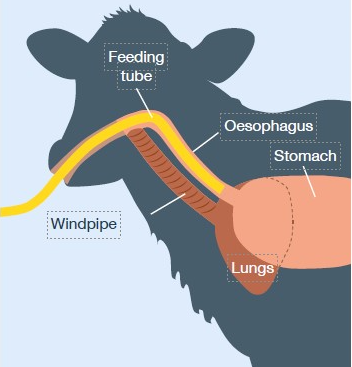Farmers are well aware of the importance of feeding calves high-quality colostrum within the first few hours of life.
However, many may be unaware of the preferred method of getting this colostrum into calves, i.e. by way of a stomach tube or teat feeder.
Colostrum
The preferred method of feeding calves colostrum is through a teat feeder or a bottle with a teat on it.
This is because teat feeding stimulates the natural reflex closure of the oesophageal groove, which means that the colostrum is deposited directly into the abomasum.

Fluid delivered by a tube feeder does not stimulate this reflex closure and thus fluid is deposited into the first three stomachs.
However, research has shown that the level of immunoglobulins in the blood of calves fed using the two methods is the same.
Ultimately, both methods are effective at feeding calves colostrum, so it really comes down to preference and/or time.
Stomach tubing
Stomach tubing is an important skill that dairy farmers should be able to use when required.

When done correctly it is a very effective way of getting colostrum into calves, but if done incorrectly it could potentially injury the calf or unfortunately, actually cause the calf to die.
When tubing calves there are some simple steps that can be followed:
- Before the tube is used it should be inspected for damage. If the tube is damaged in any way it should not be used;
- Once the tube has been inspected for damage, it should be moistened/softened at the end with warm water;
- While standing, place the calf’s back into a corner, with one hand under the muzzle to keep the head and neck in a natural position;
- Slowly pass the tube over the tongue to the back of the mouth, ensuring the tube enters the oesophagus. You should be extremely careful to ensure the tube enters the oesophagus and not the windpipe;
- When the tube is in the correct location, the calf should be comfortable and swallowing;
- But, before you allow the colostrum to flow through the tube, the placement of the tube should be double checked. This can be checked by feeling the calves neck area. You should be able to feel the stomach tube – if not, the tube may be in the windpipe;
- Once you have ensured the tube is correctly placed you can allow the colostrum to flow.
When feeding colostrum to a calf using a stomach tube, it is important that you take your time and remain calm.
You should remove the cow or calf before feeding the calf to ensure your own safety.

